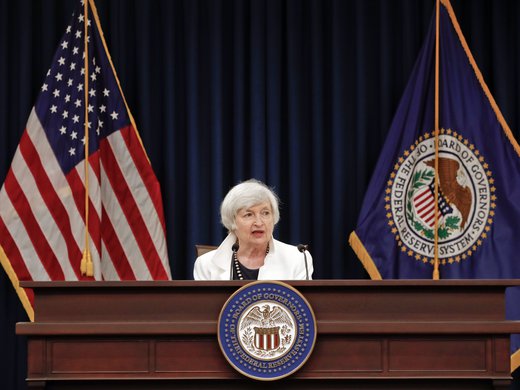It took some time, but Bank of Canada Governor Stephen Poloz and Bay Street finally seem to understand each other.
The biggest surprise around the Canadian central bank’s decision to raise interest rates on January 17 might have been how calmly the markets absorbed the shift in policy. Unlike last year’s consecutive increases in July and September, most traders saw this one coming.
The chief economists at Canada’s seven biggest banks all correctly predicted the move; prices for financial assets tied to short-term interest rates implied an 80 percent probability that the Bank of Canada would raise its benchmark a quarter point, which it did.
A few economists waited until a week before the announcement to place their final bets, but that’s okay, because it shows market participants are finally responding to data, instead of over-interpreting the central bank’s messaging. Poloz’s four-and-a-half years of conditioning are working.
This wasn’t the case last summer when a report showed GDP grew at an annual rate of 4.5 percent in the second quarter. It was an off-the-charts reading that demanded a response, particularly because the central bank that had sworn it would move when it received clear signals from data. Still, many economists and traders were surprised when the Bank of Canada raised borrowing costs.
That shock might have been exactly what market participants needed to understand how Poloz and his deputies on the Governing Council would likely respond to December’s Labour Force Survey from Statistics Canada that revealed the jobless rate fell to a record low. Policy makers have made clear their inclination to leave interest rates low, but there was no way to look past the strength of the data.
“I just find it on balance reassuring that the market reads the data similar to what we do,” Poloz said at a press conference after the latest policy announcement.
“That’s the other side of data dependence,” he added, a reference to his long-standing argument that central bankers and investors should be engaged in a two-way conversation, not one in which market actors are waiting on central bankers to tell them what to do. “The market is reacting to the data before we do,” Poloz said. “That’s very helpful.”
Let’s hope his peers are watching.
Most central bankers say they dislike the code words that have come to characterize their communications strategies. There is a general agreement that the US Federal Reserve’s tendency to telegraph its intentions contributed to the financial crisis by making the path of interest rates too predictable. A healthy debate about the state of the economy might have created doubt, giving investors an incentive to hedge. If more investors had been hedged going into 2008, the damage wouldn’t have been as severe.
But despite all that, the world’s major central banks remain reluctant to let investors walk on their own. Guidance proved useful in providing certainty during the depths of the financial crisis. Yet few have stopped providing it, even though the worst is long past. The Fed, the European Central Bank, the Bank of England and others seem to fear being the cause of too much market volatility.
Poloz is the exception.
He said that explicit forward guidance was something central bankers should provide sparingly, and that anyone who wanted to divine the path of interest rates should study the data, just as the central bank does.
This position earned him a legion of detractors. But he endured the criticism, and might now be making more friends than enemies. Instead of complaining, many analysts simply tempered their projections for Canada’s next interest-rate increase by advising their clients that policy would depend on the indicators.
“The [Bank of Canada] is more data-dependent than ever,” Frances Donald, senior economist at Manulife Asset Management, said in a note to her clients. “We believe Governor Stephen Poloz will continue to refrain from providing forward guidance, and markets will need to rely on their own interpretation of incoming data to front-run the [Bank of Canada].”
As long as the Fed and other central banks continue to speak in code, Poloz will have to contend with analysts and journalists who insist on seeking hidden meaning in the Bank of Canada’s choice of words.
In its policy statement, the Bank of Canada said that “some continued monetary policy accommodation will likely be needed to keep the economy operating close to potential and inflation on target.”
That’s an acknowledgement that if observers are expected to predict the path of interest rates on their own, policy makers must be as transparent as possible about the way they see things at any given time. And yet, there were those who wanted more. At the press conference, Poloz was forced to reassure that the word “some” in that sentence means the same as it does in “everyday language,” and nothing more.
Canada’s central bank still is less transparent than many of its peers. It doesn’t release minutes of its policy meetings, it doesn’t keep transcripts and it doesn’t allow the deputies on the Governing Council to say much publicly. At the same time, the institution is putting a lot of thought into how a modern central bank should communicate with the public.
Communication is on the agenda for the next mandate review, and policy makers have shown a willingness to tinker in real time. Previously, four of the Bank of Canada’s eight annual policy announcements were made without any context beyond the 400 or so words in statement. Starting this year, the central bank will ensure that each of those interest-rate decisions is closely followed by a speech and a press conference.
That’s a positive change, if policy makers are forthcoming about how they are interpreting economic developments. Based on recent events, there is reason to think that they will be.



